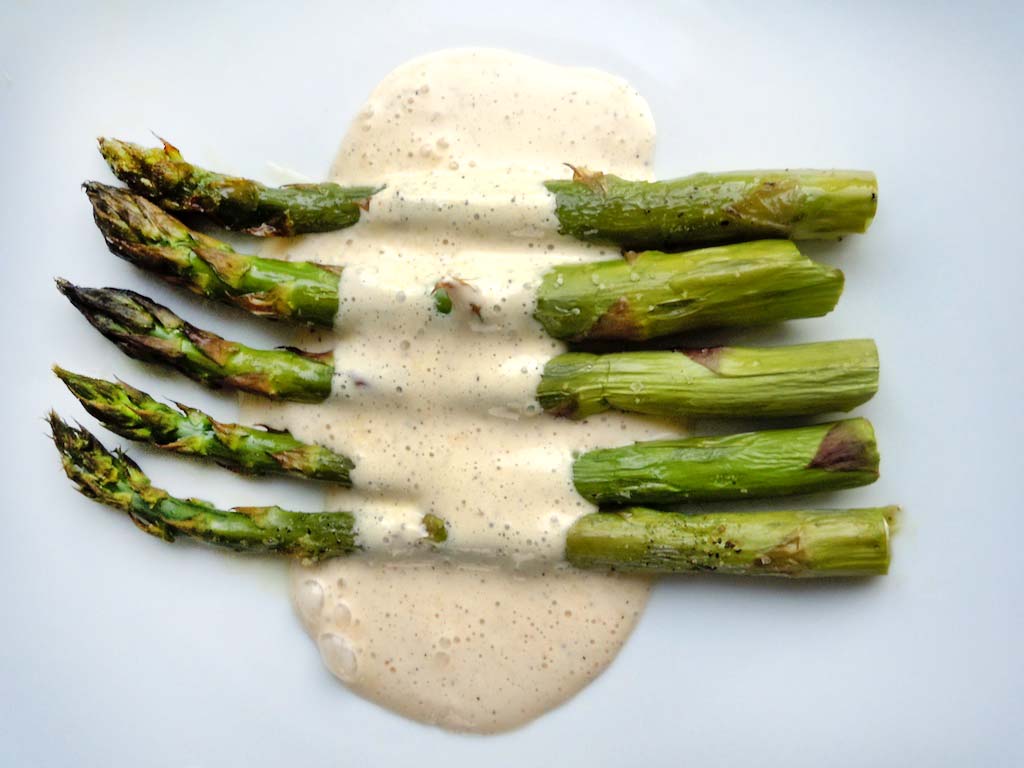
[A] few weeks ago, I sat down to begin writing of a delicious hollandaise sauce I had made in the blender, when I read the words of Julia Child in Vol. 1 of “Mastering the Art of French Cooking”: “It is extremely easy and almost foolproof to make in the electric blender, and we give the recipe on page 81, ” Child wrote of the rich lemony sauce. “But we feel it is of great importance that you learn how to make hollandaise by hand, for a part of every good cook’s general knowledge is a thorough familiarity with the vagaries of egg yolks under all conditions.”
OK, Julia. I would shelve my observations of the blender method a moment more to make hollandaise by hand. After all, the stovetop/double-boiler version would take only “5 minutes,” according to the great French chef icon.
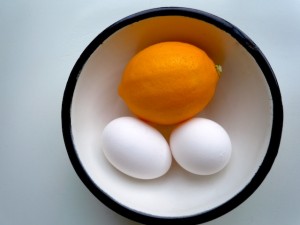 Hollandaise sauce, if you have never experienced it, is a rich, lemony, buttery egg yolk concoction that can be used to dress any number of dishes, from fish to asparagus to that classic of breakfast elegance, Eggs Benedict. It can be made easily from packets found in the grocery store sauce and gravy sections, but, as Julia encouraged, it is easy enough to create from scratch. Be not afraid!
Hollandaise sauce, if you have never experienced it, is a rich, lemony, buttery egg yolk concoction that can be used to dress any number of dishes, from fish to asparagus to that classic of breakfast elegance, Eggs Benedict. It can be made easily from packets found in the grocery store sauce and gravy sections, but, as Julia encouraged, it is easy enough to create from scratch. Be not afraid!
A little (that means little) heat, butter, egg yolks, lemon juice, salt and pepper and even a pinch of cayenne are fused for this sauce in a process Julia described as “forcing egg yolks to absorb butter and hold it in creamy suspension.”
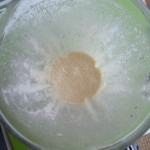 No hard cooking happens here…the heat is applied delicately, just enough to cook the yolks to a creamy and safe rendition. In the blender method, the heat comes from pouring hot melted butter into a churning blender containing the egg yolks, lemon juice and seasoning. This was so easy and so successful, I would happily make it again and again, celebrating the fact that I could master a technique that Julia said was “well within the capabilities of an 8-year-old child…”
No hard cooking happens here…the heat is applied delicately, just enough to cook the yolks to a creamy and safe rendition. In the blender method, the heat comes from pouring hot melted butter into a churning blender containing the egg yolks, lemon juice and seasoning. This was so easy and so successful, I would happily make it again and again, celebrating the fact that I could master a technique that Julia said was “well within the capabilities of an 8-year-old child…”
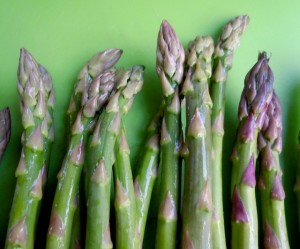 This sauce was thick and creamy, just lemony enough. It was very butter rich, so paring it with a vegetable — in this case, asparagus coated in olive oil and salt and paper and roasted in the oven for several minutes at 400 degrees — reduced the guilt, because clearly, that would not be happening with the butter.
This sauce was thick and creamy, just lemony enough. It was very butter rich, so paring it with a vegetable — in this case, asparagus coated in olive oil and salt and paper and roasted in the oven for several minutes at 400 degrees — reduced the guilt, because clearly, that would not be happening with the butter.
I was satisfied, felt successful and ready to post, as mentioned earlier, but then, a new type of guilt prodded me toward making a second batch of hollandaise (and really, who could argue against more). Since I was going to the “trouble” of making hollandaise in the traditional method, I decided to let the sauce dress its most traditional companion dish — Eggs Benedict.
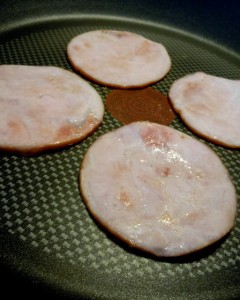
Eggs Benedict traditionally is a breakfast/brunch all-star of decadence that is a layer of toasted English muffin, topped with ham or Canadian bacon, a poached egg and a slathering of hollandaise. Various sources seem to indicate that no one is certain of the origin of Eggs Benedict, whether it was a hangover cure for a New Yorker or an egg-y craving of an 18th-century pope, we can’t be certain, but we are happy Eggs Benedict was brought into being.
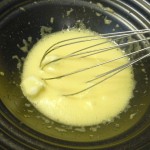 I did find this sauce to be easy to create, making sure I heated egg yolks over mildly simmering water, gradually adding solid bits of butter, then whisking in melted butter at the end for the final creamy emulsion.
I did find this sauce to be easy to create, making sure I heated egg yolks over mildly simmering water, gradually adding solid bits of butter, then whisking in melted butter at the end for the final creamy emulsion.
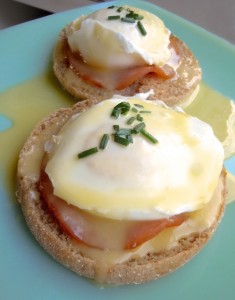
Tastewise, this sauce was every bit as flavorful as the blender version and I found satisfaction in bringing it to life by hand. I did find the consistency slightly thinner, however, and would probably attribute that to my lack of whipping power versus the blender. Still, it was a delight to have a restaurant-worthy breakfast for dinner one evening!
Either method will not disappoint. And I’ll use any excuse to poach an egg. That’s just good clean fun!
Roasted Asparagus with Hollandaise
From: Ina Garten/Barefoot Contessa
8 servings
12 tablespoons unsalted butter (1 1/2 sticks)
4 extra-large egg yolks, at room temperature
3 tablespoons freshly squeezed lemon juice
Kosher salt and freshly ground black pepper
2 pinches of cayenne pepper
2 pounds fresh asparagus
Good olive oil
Directions
Preheat the oven to 400 degrees.
Melt the butter in a small sauce pan. Place the egg yolks, lemon juice, 1 1/2 teaspoons salt, 3/4 teaspoon pepper and cayenne in the jar of a blender. Blend for 15 seconds. With the blender running, slowly pour the hot butter into the blender and blend for 30 seconds, until the sauce is thick. (You can leave it in the blender at room temperature for up to 1 hour. If it is made in advance, add 1 tablespoon hot tap water and blend for a few seconds before serving.)
Break off the tough ends of the asparagus and, if they’re thick, peel them. Place the asparagus on a baking sheet, drizzle with olive oil, then toss to coat the asparagus completely. Spread the asparagus in a single layer and sprinkle liberally with salt and pepper. Roast the asparagus for 15 to 20 minutes, until tender but still crisp.
Pour the hollandaise sauce over the warm asparagus and serve.
Hollandaise Sauce
From “Mastering the Art of French Cooking, Vol. I” (1961)
Makes 1 to 1½ cups hollandaise, serving 4 to 6
6 to 8 ounces of butter (¾ to 1 cup or 1½ to 2 sticks)
3 egg yolks
1 tablespoon cold water
1 tablespoon lemon juice
Big pinch of salt
Salt and white pepper
Drops of lemon juice
2 tablespoons cold butter
Cut the 6 to 8 ounces butter into pieces and melt it in the saucepan over moderate heat. Then set it aside.
Beat the egg yolks for about 1 minute in a medium saucepan, or until they become thick and sticky.
Add the water, lemon juice, and salt, and beat for half a minute more.
Add 1 tablespoon of cold butter, but do not beat it in. Then place the saucepan over very low heat or barely simmering water and stir the egg yolks with a wire whip until they slowly thicken into a smooth cream. This will take 1 to 2 minutes. If they seem to be thickening too quickly, or even suggest a lumpy quality, immediately plunge the bottom of the pan in cold water, beating the yolks to cool them. Then continue beating over heat. The egg yolks have thickened enough when you can begin to see the bottom of the pan between strokes, and the mixture forms a light cream on the wires of the whip.
Immediately remove from heat and beat in the other tablespoon of cold butter, which will cool the egg yolks and stop their cooking.
Then beating the egg yolks with a wire whip, pour on the melted butter by droplets or quarter-teaspoonfuls until the sauce begins to thicken into a very heavy cream. Then pour the butter a little more rapidly. Omit the milky residue at the bottom of the butter pan.
Season the sauce to taste with salt, pepper, and lemon juice.
Notes (from book)
Keeping the sauce warm
Hollandaise is served warm, not hot. If it is kept too warm, it will thin out or curdle. It can be held perfectly for an hour or more near the very faint heat of a gas pilot light on the stove, or in a pan of lukewarm water. As hollandaise made with the maximum amount of butter is difficult to hold, use the minimum suggested in the recipe, then beat softened or tepid butter into the sauce just before serving.
If the sauce is too thick
Beat in 1 to 2 tablespoons of hot water, vegetable cooking liquid, stock, milk, or cream.
If the sauce refuses to thicken
If you have beaten in your butter too quickly, and the sauce refuses to thicken, it is easily remedied. Rinse out a mixing bowl with hot water. Put in a teaspoon of lemon juice and a tablespoon of the sauce. Beat with a wire whip for a moment until the sauce creams and thickens. Then beat in the rest of the sauce half a tablespoon at a time, beating until each addition has thickened in the sauce before adding the next. This always works.
If the sauce curdles or separates—“turned sauceâ€
If a finished sauce starts to separate, a tablespoon of cold water beaten into it will often bring it back. If not, use the preceding technique.
Leftover hollandaise
Leftover hollandaise may be refrigerated for a day or two, or may be frozen. It is fine as an enrichment for veloutés and béchamels; beat it into the hot white sauce off heat and a tablespoon at a time just before serving.
If the leftover sauce is to be used again as a hollandaise, beat 2 tablespoons of it in a saucepan over very low heat or hot water. Gradually beat in the rest of the sauce by spoonfuls.